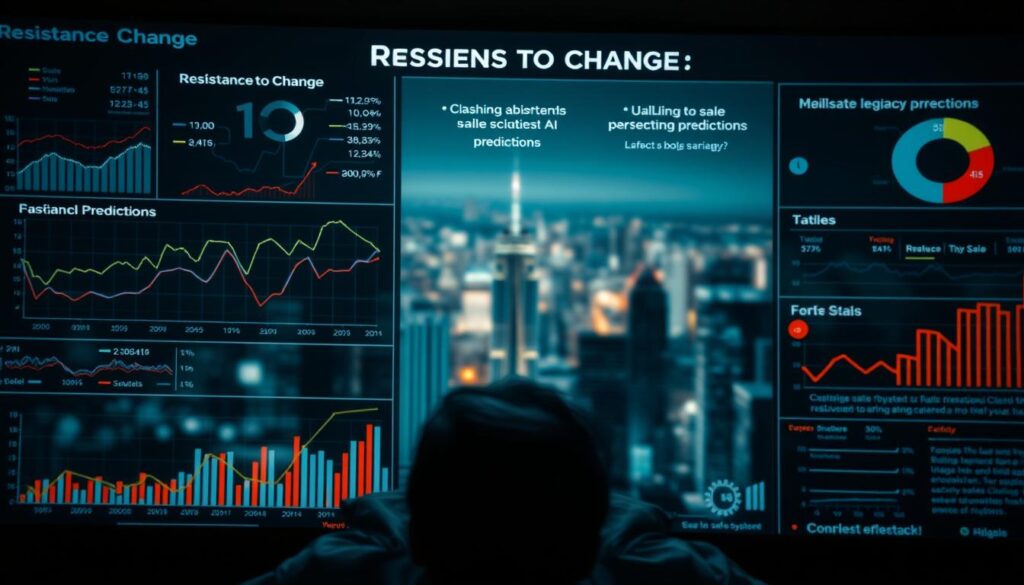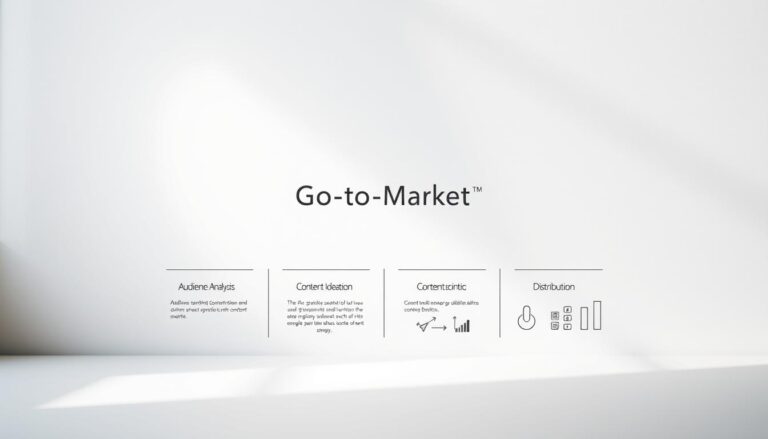These days, companies are increasingly using AI-driven sales forecasting to be more accurate and effective. By using artificial intelligence (AI) and predictive analytics, they can improve how they predict sales. This is not only about making better sales forecasts. It’s also about improving sales in different areas.
Making accurate sales forecasts is key for deciding how to use resources and manage inventory. But, studies show less than 20% of sales teams are 75% accurate in their forecasts. This shows a huge need for new methods. Companies using AI for sales forecasts can better handle market changes and set realistic goals for money they expect to make.
Key Takeaways
- AI-driven sales forecasting significantly improves prediction accuracy.
- Predictive analytics is central to optimizing sales performance.
- Organizations face a challenge with traditional sales forecasting methods.
- Enhanced data analysis leads to better resource allocation decisions.
- Less than 20% of sales teams achieve high forecast accuracy without AI.
- AI integration is crucial for staying competitive in the market.
Understanding AI-Driven Sales Forecasting
Sales forecasting guesses future sales using past data and market trends. It helps businesses plan resources and meet demands. Traditional forecasts often rely on guesswork, leading to mistakes. AI-driven sales forecasting uses technology to better predict sales outcomes.
What is Sales Forecasting?
Sales forecasting helps estimate future sales. It uses past sales, trends, and economic signs. Businesses apply different methods to create these forecasts. Automated sales forecasting reduces human mistakes, making predictions more reliable.
The Role of AI in Sales Forecasting
AI changes sales forecasting into a data-focused task. It uses machine learning to analyze huge data sets quickly. These systems spot patterns that people might miss. With better predictions, businesses can fine-tune their sales plans, improving results. To improve sales predictions, companies can use machine learning performance tools.
| Forecasting Method | Advantages | Limitations |
|---|---|---|
| Traditional Methods | Simple to implement, low cost | Subject to biases, less accurate |
| AI-Driven Forecasting | Higher accuracy, adapts to changes | Requires substantial data and resources |
Benefits of AI-Driven Sales Forecasting
AI-driven sales forecasting brings many benefits, changing how businesses plan their sales. It uses advanced tech to make the sales process better and faster. This makes these tools vital for firms wanting to do better.
Improved Accuracy and Precision
AI helps make sales forecasts much more accurate. It looks at a lot of data to spot patterns humans might not see. This means forecasts are more trustworthy. Sales teams can then set goals that are realistic. This push towards better accuracy makes everyone rely more on data. It builds trust in the sales plans and daily work.
Increased Efficiency in Sales Processes
AI also makes sales work more efficient. It takes over simple tasks like gathering and organizing data. This lets the team focus on more important things. The result? Better productivity and forecasting. This leads to better sales and a stronger position against competition.

Key Technologies Behind AI Sales Forecasting
Understanding the key technologies in AI sales forecasting helps businesses fine-tune their strategies. It’s about machine learning algorithms and data analytics tools. These elements work together, letting companies use cutting-edge methods to make sales forecasts more accurate and their operations more efficient.
Machine Learning Algorithms
Machine learning is critical for predicting sales. It uses powerful algorithms, like XGBoost and Random Forest, to sift through large data sets. This process finds patterns that affect sales. By understanding these patterns, companies can make choices based on solid data.
Data Analytics Tools
Data analytics play a huge role in forecasting software for sales. These tools pull valuable insights from all kinds of data. With advanced data analysis, companies can forecast more accurately. They can quickly adapt to market shifts and shape their strategies better.
| Technology | Purpose | Advantages |
|---|---|---|
| Machine Learning Algorithms | Analyzing data for predictive insights | Improved accuracy and identification of trends |
| Data Analytics Tools | Extracting and interpreting data | Informed decision-making and strategic adjustments |
Data Sources for Accurate Sales Forecasting
To forecast sales accurately, businesses must use diverse data sources. Internal sales details are vital for this goal. These details include previous sales, customer talks, and current deals in progress. By merging this info, firms set a robust basis for predicting sales. Moreover, keeping an eye on market trends and shopper habits helps a lot. Knowing how consumer tastes change, along with economic signs, helps refine business plans.
Internal Sales Data
For precise forecasts, internal sales info is key. It includes various factors like:
- Historical sales records
- Customer engagement metrics
- Sales team performance analytics
- Lead conversion rates
Looking at these elements helps spot patterns. Patterns that shape what they sell next.
Market Trends and Consumer Behavior
Understanding market trends and what customers want is crucial for planning. You can get insights from:
- Social media analytics
- Surveys and customer feedback
- Competitor benchmarking
- Economic forecasts
Tracking these trends helps firms keep up and refine how they predict sales. How shopper taste evolves and market changes occur really dictates forecast adjustments.
| Data Source | Importance | Use Case |
|---|---|---|
| Internal Sales Data | Foundation for analysis | Predicting quarterly sales |
| Market Trends | Context for strategy | Adapting marketing approaches |
| Consumer Behavior | Understanding buyer preferences | Enhancing product development |
Implementing AI-Driven Sales Forecasting in Your Business
Putting AI-driven forecasting into your business needs a good plan. It’s all about getting your sales team the right tools to boost their sales. This makes things run smoother and work better.
Steps to Integration
- Data Collection and Preparation: Gather relevant data from multiple sources, ensuring its accuracy and completeness.
- Defining Objectives: Clearly outline your goals for sales forecasting, aligning them with business needs.
- Selecting Forecasting Models: Choose an appropriate AI-driven forecasting model that fits your specified objectives.
- Integrating Tools: Seamlessly incorporate AI tools with existing CRM and business intelligence systems for a holistic approach.
- Continuous Monitoring: Regularly assess model performance, making adjustments as needed to improve accuracy.
Best Practices for Successful Implementation
- Focus on Data Quality: Ensure that the collected data is clean and reliable to strengthen forecasting results.
- Training and Support: Provide adequate training for your sales teams to utilize new tools effectively.
- Regular Updates: Continuously update forecasting models with new data to maintain relevancy and precision.
- Collaboration: Foster a culture of collaboration between sales, marketing, and IT for a unified approach.
Challenges in AI-Driven Sales Forecasting
Adding AI into sales forecasting brings big challenges for companies. They need to understand their data quality and deal with people’s resistance to change. Tackling these issues is key to making the most of new tech.
Data Quality and Availability
For sales forecasting to work well, it needs good data. But bad data can mess things up big time. The main things to watch are if the data is consistent, correct, and easy to get to.
If the data’s all over the place, predictions won’t be trustworthy, which can mess up decisions. Companies should check their data is good to make smart, data-led decisions. Better data quality means AI can really do its job.
Resistance to Change
Bringing in AI changes how sales work, and not everyone likes change. People might worry about losing their jobs or not understanding new tech. To get everyone on board, talk openly about these issues and train staff well.
By managing change well, companies can build a culture that loves new ideas. This helps everyone move smoothly to using AI for making decisions.

| Challenge | Description | Impact on Sales Forecasting |
|---|---|---|
| Data Quality | Poor, inconsistent, or incomplete data | Leads to inaccurate forecasts and decision making |
| Resistance to Change | Staff reluctance to adopt new technology | Can slow the implementation process, limiting effectiveness |
| Integration Issues | Challenges in combining AI systems with existing software | Delays in achieving desired forecasting accuracy |
| Cost of Implementation | High expenses related to technology adoption | Can limit resources available for other initiatives |
Case Studies: Success Stories of AI in Sales Forecasting
Case studies show how organizations use AI to improve sales forecasts. These stories highlight increased accuracy and better sales management. Insights from these examples help enhance sales rates and lower errors.
Companies Leading the Way
Rogers Communication is a prime example, using the AI-powered SalesChoice Insight Engine to boost efficiency. This move led to 80% sales forecasting accuracy, making the forecast process more reliable. The company also achieved 90% accuracy in predicting sales losses early in the cycle, showing AI’s power to change business.
Measurable Outcomes and Improvements
These case studies show AI’s big impact on sales strategies. By adopting AI, companies have seen better forecast accuracy and sales improvements. This switch to data-driven methods has spurred innovation in sales. For more on this topic, check out detailed case studies here.
Future Trends in AI-Driven Sales Forecasting
AI-driven sales forecasting is rapidly changing. This is due to advances in machine learning and data handling. These trends will likely lead to better accuracy in predicting sales, helping companies plan better. With new tech, businesses can expect deeper insights. This helps them make smart choices in a fast-paced market.
Evolving Technologies and Methods
New tech like advanced analytics and integrated software will shape sales forecasting. More companies are using these techs to make sense of big data. This lets them see trends and customer habits more clearly, giving them an edge in a quick-moving market.
The Impact of AI on Sales Strategies
AI will change how sales strategies are made by making them more adaptable. By using AI insights, teams can match their plans with the latest data. This helps salespeople find the best opportunities and improve how they connect with customers. With AI, companies can stay nimble and ahead, even when facing new challenges.
FAQ
What is AI-driven sales forecasting?
AI-driven sales forecasting uses machine learning and predictive analytics. It makes sales predictions more accurate. This helps companies make smart decisions about how to use resources and manage inventory.
How does predictive analytics improve sales forecasting?
Predictive analytics looks at big datasets to find patterns. These patterns make sales forecasts more precise. It’s better than old methods relying on guesswork and manual changes.
What technologies underpin AI-driven sales forecasting?
Important technologies include machine learning models like XGBoost and Random Forest. There are also data analytics tools. They help understand insights from data, both structured and unstructured.
Why is data quality important in sales forecasting?
Good data is vital for accurate forecasts. Bad data leads to big mistakes in forecasting and sales plans.
What are the best practices for implementing AI-driven sales forecasting?
Best practices involve making sure data is good. Also, matching forecasting models with business goals is key. Plus, integrate AI with CRM systems. Always check how things are going to tweak as needed.
What challenges might organizations face when adopting AI-driven sales forecasting?
Organizations might struggle with poor data or not having enough data. Also, some teams might not want to give up old forecasting ways.
Can you provide examples of organizations benefiting from AI-driven sales forecasting?
Many top companies have seen great results with AI in forecasting. They’ve got better at turning leads into sales and made fewer forecasting mistakes. It shows how powerful these new tools can be.
What future trends can we expect in AI-driven sales forecasting?
We expect better machine learning algorithms and more powerful data processing. AI will become a bigger part of sales. This will help companies quickly adjust to market changes and hone their sales tactics.



